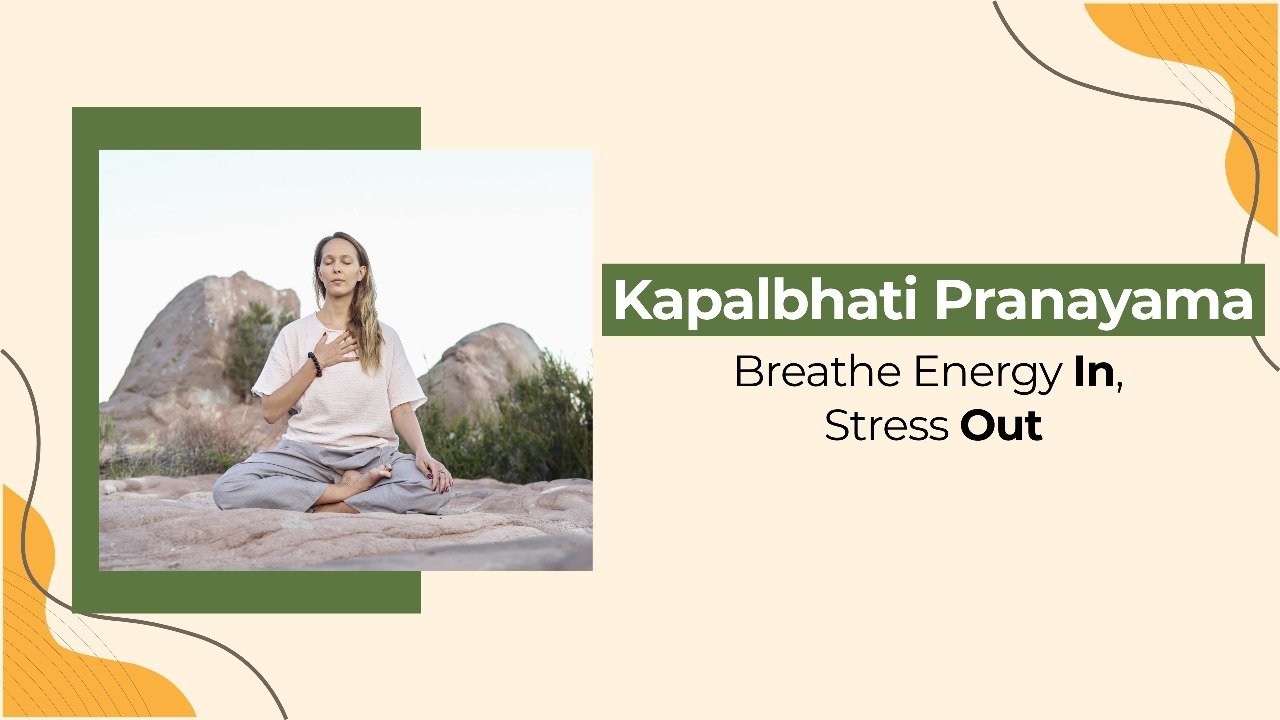If you’ve ever wanted one practice that wakes you up, clears your mind, boosts your focus and supports your heart health — this is it.
Say hello to Kapalbhati Pranayama — a fiery, energizing breathwork technique from yoga that literally translates to “shining skull.” And no, it’s not as intimidating as it sounds. It’s a practical, science-backed way to hit reset on your nervous system and feel more alive, alert, and at ease.
This blog is for you if:
- You wake up foggy, groggy, or stressed
- You feel your breath is shallow and tight
- You deal with high BP, anxiety, or mental exhaustion
- You want a 5-minute daily ritual that actually works
Let’s dive into how this one breath technique can energize your body and soothe your mind.
So, What Is Kapalbhati?
Kapalbhati (kah-pahl-BAH-tee) is a yogic breathing technique where the exhalation is forceful and active, and the inhalation is passive and automatic. You sit still, but your breath does the work, pumping out stale air, mental fog, and sluggishness with every round.
Think of it like blowing out stress, one breath at a time.
Traditionally, it’s been used to cleanse the mind, stimulate digestion, and build inner energy (prana). But what does modern science have to say?
What the Research Says and Why It Matters
A 2020 study published in the Journal of Complementary and Integrative Medicine looked at the immediate effects of Kapalbhati on heart rate variability (HRV), a marker that reflects how well your heart and nervous system handle stress.
Here’s the breakdown:
- Volunteers practiced Kapalbhati for 5 minutes. Another group rested with normal breathing.
- HRV data was collected before, right after, and 20 minutes later.
- Results? Kapalbhati initially activated the sympathetic nervous system, that’s your “fight or flight” response, but 20 minutes later, the body shifted into a calm, parasympathetic state. In simple words: a burst of energy followed by a wave of deep calm.
That’s gold for your heart. Why? Because improving your ability to move between states of alertness and relaxation is what keeps your heart, breath, and brain resilient, especially in today’s overstimulated world.
In Simple Terms:
Kapalbhati revs you up, then cools you down.
It’s like drinking a double espresso, but instead of anxiety and a crash, you get mental clarity, focused energy, and a calmer nervous system after.
And when practiced regularly, that adds up to:
- A more balanced heart rate
- Better stress regulation
- Lower baseline anxiety
- Sharper focus without the burnout
- Boosts lung capacity and respiratory strength
- Supports digestion by stimulating abdominal organs
- Improves circulation and oxygen
- May support metabolism and fat loss
Basically, it’s cardio for your nervous system, without leaving your mat.
How to Practice Kapalbhati (The Basics)
Start slow. Stay consistent.
- Sit comfortably with a straight spine (cross-legged or on a chair).
- Rest your hands on your knees or thighs.
- Take a deep inhale.
- Exhale sharply through the nose by pulling your belly in. Don’t worry about inhalin, it’ll happen passively.
- Continue short, quick bursts of exhale, about 1 exhale per second.
- Start with 30 seconds or 30 pumps, then pause and observe.
- Repeat for 2–3 rounds, slowly increasing time as you get comfortable.
You should feel energized, not strained. If dizzy, stop and rest.
Practical Tips for Daily Practice
- Morning Ritual: Do it on an empty stomach for 1–3 minutes as a wake-up ritual. It sets the tone for focus and energy.
- Post-Meal? Skip It. Always practice at least 2 hours after a full meal.
- Combine with Stillness: Follow it up with 1 minute of deep, silent breathing. The contrast deepens the calming effect.
- Pair It with Journaling: After Kapalbhati, your mind is sharper. Use that state to write 3 intentions or gratitudes, it amplifies mental clarity.
- Consistency Over Intensity: It’s better to do 1 minute every day than 5 minutes once a week.
Who Should Skip or Modify
If you’re pregnant, recovering from recent surgery, or dealing with hypertension, heart issues, or hernia, skip this or do it only under expert guidance.
Listen to your body. Breath is medicine, when used wisely.
Ready to Try?
Start with one minute of Kapalbhati tomorrow morning. Notice how your energy shifts.
Subscribe to our newsletter for weekly breath, food, and movement rituals for your heart.
Share this with someone who overthinks or wakes up tired; they might just need this breath more than coffee.
Citations:
Based on the study: Lalitha S et al., J Complement Integr Med. 2020;18(1):155-158. and supporting literature.
__________________________________


